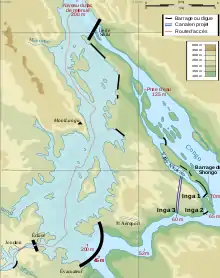Grand Inga Dam
The Grand Inga Dam (French: Barrage du Grand Inga) is a series of seven proposed hydroelectric power stations at the site of the Inga Falls, in the Democratic Republic of the Congo.[1] If built as planned, the 40-70 GW project[2][3] would be the largest power station in the world.[4]
| Grand Inga Dam | |
|---|---|
 Location of the Grand Inga Dam (lower centre), along with other Inga Dams | |
 Location of Grand Inga Dam in Democratic Republic of the Congo | |
| Country | Democratic Republic of the Congo |
| Coordinates | 05°32′48″S 13°35′06″E |
| Status | Proposed |
| Power Station | |
| Installed capacity | 40-70 GW |
Location
The project would be located across the Congo River, approximately 150 kilometres (93 mi), upstream of where the river empties into the Atlantic Ocean.[4] This is approximately 225 kilometres (140 mi), southwest of Kinshasa, the capital and largest city of the DR Congo.[4] This is the site of the Inga Falls and is the location of the 351 MW Inga 1 Hydropower Station and the 1,424 MW Inga 2 Hydropower Station, approximately 40 kilometres (25 mi) upstream of Matadi, the country's largest port.[5]
Overview
The project would involve building a dam across the south of the Bundi River valley where it meets the Congo, then diverting the Congo from above the waterfalls into the north of the valley to create a huge reservoir.[6] It is anticipated that the vertical drop, the volume and velocity of water flow at this site, can support a series of hydroelectric power stations, each with generation capacity ranging from 4 to 8 GW for a total of 40 GW for the whole complex. Inga III Power Station with capacity of 4.8 GW, would be the first power station in the series, to be constructed.[7] The current design allows for the independent development of the different power stations in the series, as well as the phased development of each station. Each of the seven dams could be owned by different investors.[4]
Financing
The total construction bill for Grand Inga has been calculated to be as high as $80 billion. The World Bank, the European Investment Bank and the African Development Bank, have provided funding for feasibility and environmental impact studies. In 2016, the World Bank cancelled its support for the Grand Inga Project. It is expected that the power stations will be developed as a public private partnership project.[4]
Recent developments
In June 2020, the Government of the Democratic Republic of the Congo resolved to present the project to the regional heads of State and explore the market on the continent for the power generated. They have recruited the African Union and the New Partnership for Africa's Development in their efforts to get the power station built.[1] South Africa has indicated willingness to buy 2.5 GW of the dam's output. Nigeria is interested in buying 3 GW and the Congolese mines in Katanga Province are interested in 1.3 GW.[7]
See also
References
- Patrick Ilunga (20 June 2020). "DRC Goes On With Grand Inga Dam Project". The EastAfrican. Nairobi. Retrieved 22 June 2020.
- David Rogers (30 September 2015). "Democratic Republic of Congo seeks professionals to build revolutionary Grand Inga Hydro scheme". London, United Kingdom: Global Construction Review. Retrieved 19 March 2021.
- Africa Intelligence (11 March 2021). "Fortescue in Kinshasa to negotiate Grand Inga mega-contract". Paris, France: Africa Intelligence. Retrieved 19 March 2021.
- International Rivers (2015). "Grand Inga Dam, Democratic Republic of the Congo". Oakland, California, United States: International Rivers. Retrieved 22 June 2020.
- The Editors of Encyclopaedia Britannica (22 June 2020). "Profile of Inga Falls". London: Encyclopaedia Britannica. Retrieved 22 June 2020.
- Jullien, Maud (15 November 2013), Can DR Congo's Inga dam project power Africa?, Inga: BBC, retrieved 4 September 2020
- Maud Jullien (15 November 2013). "Can DR Congo's Inga dam project power Africa?". London: BBC News. Retrieved 22 June 2020.
External links
- Construction of US $14bn Grand Inga dam in Congo on track As of 5 November 2019.